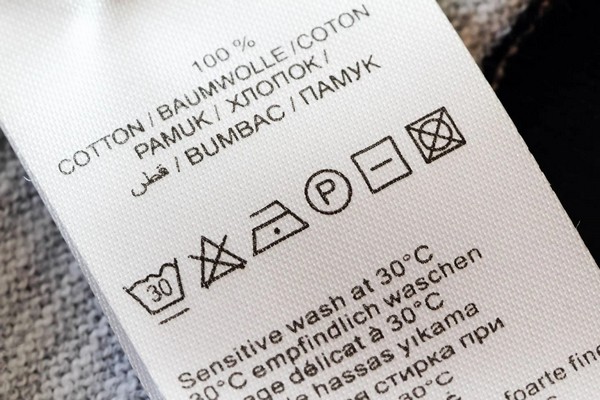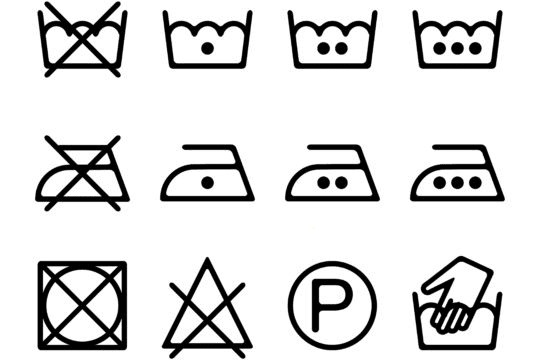What is Care Label?
The care label is defined as a label or other affixed instructions that indicate how a product should be treated. A care label shows a number of pictorial symbols that give directions for restoring or ‘renewing’ the consumer textile product. The symbols portray care instructions which are directions that describe practices which should treat a product without adverse effects, and warn against any action which may be used and which could harm the item.

Basically, care label is tag that present information about clothing and textile product for the purpose of aiding the consumer in selection. Care label symbols gives some information like
- Fabric content
- How the fabric is made?
- How it will perform in use.
- Importers identification number.
- Country of origin.
- Care instruction.
In a piece of garment, we usually have 2 to 3 pieces of woven label. These labels may be with a logo and some wording woven or printed in them. However, the labels must be made in a material which can last as long as the garment with the wording legible after many washing. Labels should always be sewn on. Glued on label or sticker labels are generally not acceptable.
Types of Care Label Symbols:
- Main label
- Size label
- Label of fiber contents, RN number and country of origin
- Care label
1. Main label:
Generally this is a design or brand name. You do not have to put any information there, but if buyer wish to do that, then it is ok.
2. Size label:
Size label mainly present the size of the garment. Standard size symbols are used here and attaching into the seams under the main label of garments. Alphabetic size symbols are XXS, XS, S, M, L, XL, XXL, XXXL.
3. Label of fiber contents, RN number and country of origin:
We should make a label to contain these 3 things to be sewn right next to the main label. The label should be readily visible. Manufacturers should follow the buyer’s instruction.
4. Care label:
It should contain clear washing, ironing, drying instructions and can be sewn in a place not readily visible such as the side seam of a shirt or a jacket. In this article I will explain about care labelling.
Why is Care Labelling is Important?
Care label symbols provide the public with enough information to:
- Avoid damage such as dyes running (e.g. wash separately).
- Have prior knowledge of costs such as dry cleaning in the ongoing care of clothing and textile products
- Know how to care for clothing and textile products
- Maximize the useful life of clothing and textile products
- Understand how to clean clothing and textile products properly (e.g. cold hand wash only)
General Information of Care Label Symbols:
Care label is the most important things for clothing and textile products. Care label provide the durability and maintenance of a textile product during its normal period of usage. For this reason, many clothing manufacturers provide consumers with additional information regarding maintenance of their clothing, in order to help them get the most out of it for as long as possible.

Care performed on the basis of the information given on the label provides a guarantee that the textile product will not be damaged. It does not, however, guarantee that all varieties of dirt and stains will be removed. It is mainly present maintenance information like cleanliness, size, physical integrity and color, as they were when purchased, taking into account wear, usage, and/or care procedures.
Care label is very important that the consumer given accurate information as to how to take care of their garments, so that they can make informed purchase decisions concerning the care characteristics.
Before buyer decide what care instruction they will put on the care labels, test the clothing and textile products under consideration and make the care instructions are proper. In testing, effects of their care instructions on the following properties of clothing should be taken into consideration:
- Shrinkage or growth (Dimensional stability)
- Color fastness. Tendency to yellow if the product is white.
- General condition-overall appearance after washing or dry cleaning (such as durable press appearance, opening-up or fraying of seams etc.)
- Change in body or hand.
- Delaminating
- Change in seam and fabric strength.
Recommendations for Care Labeling:
A care label is a permanent label or tag, containing regular care information and instructions for the ordinary user of the product. It is attached or affixed in such a manner that it will not become separated from the product, and will remain legible during the useful life of the product. Care-label recommendations on an item of clothing includes various instructions regarding washing, bleaching, drying, ironing and dry-cleaning, by following standard procedures. When determining what to include on a care label, there are certain options to be considered, depending on the performance of the clothing.
Care Labeling Systems:
Care labels provide information on the maximum permitted treatments and the proper care of clothing and textiles. They are intended both for consumers and for those companies, such as launderettes and dry-cleaners, responsible for the care of textiles. Care labeling is not mandatory at EU level, but at Member State level the situation varies. In most of the older Member States (EU-15 except Austria and Finland) and in Slovenia, Lithuania, Malta, and
Cyprus, care labeling is optional, whereas many of the new Member States have mandatory care-labeling requirements (Euratex, 2007; IMCO, 2010).
Both the optional care-labeling systems applied by manufacturers and importers, and those legally required in the Member States where care labeling is mandatory, are generally based on the ISO 3758: 2005 standard, which, in turn, is based on the care symbols developed by GINETEX. GINETEX has devised an internationally applicable care-labelling system for textiles based on symbols. The pictograms used are registered trademarks and are the property of GINETEX. These symbols are protected by a trademark owned by GINETEX (2010). (GINETEX means Groupement International Etiquetage pour /Entretien dex Textiles)
In 2012 a new, revised care-labeling standard, EN ISO 3758: 2012, was published, which will replace the previous version. One of the main changes in the new standard, which will affect retailers and brands, is the revision of the appearance of the ‘Do not bleach’ symbol. This has now reverted to a lined version. Several of the main EU trade partners have mandatory care-labeling systems, including the USA, Japan, Australia and China. The new standard brought care-labeling instructions into alignment with the international care-label standard ISO 3758.
Care Labeling Code Using Symbols:
Care labeling, which states the level of regular care necessary for the ordinary use of the product, is determined by the International Standard ISO 3758: 2012. This international standard establishes a system of graphic symbols, intended for use in the marking of textile articles, which provide information to prevent irreversible damage to the article during the textile care process and specifies the use of these symbols in care labeling.
The following domestic treatments are covered in care labeling:
Washing – A process designed to clean textile articles in an aqueous bath. This operation may be carried out by machine or by hand.
Bleaching – A process carried out in an aqueous medium before, during, or after washing and, which requires the use of an oxidizing agent, including either chlorine or oxygen/non-chlorine products.
Drying after washing – A process carried out on textile articles after washing to remove excess water (or moisture).
Ironing – A process carried out on a textile article to restore its shape and appearance by means of an appropriate appliance using heat, pressure and possibly steam.
Professional textile care – Professional dry-cleaning and professional wet cleaning, excluding commercial laundering.
Five basic symbols and four additional symbols are provided to outline how a user should care for a particular item of clothing or textile product. The care label provides instructions on what to do and what not to do when cleaning or caring for the product.
The basic care symbols with care instructions are shown in below with a table. This International Standard applies to all textile articles in the form in which they are supplied to the end user.
The basic care label symbols:
| Treatment | Description | Symbol | Instruction |
| Washing | For the washing processes, a washtub as shown |  | The symbol indicates weather domestic washing is possible and applies both to hand and machine washes. |
| Bleaching | For the bleaching processes, a triangle as shown. |  | The symbol indicates whether the article may or may not be bleached |
| Drying | For the drying processes, a square as shown |  | The square is the symbol of the drying Process. The circle inside the square is a reference to tumble drying; the line(s) inside the square symbolizes natural drying after the washing process |
| Ironing | For the ironing and pressing processes, a hand iron shape as shown |  | The dots indicate the temperature ranges for ironing |
| Professional textile care | For the professional dry-cleaning and professional wet cleaning processes (excluding commercial laundering), a circle |  | The symbol gives information on the possibility of professional dry or wet cleaning |
Application and Uses of Care Label Symbols:
Application of symbols:
- The symbols shall be placing either directly on a label which shall be affixed in permanent manner.
- Label and symbols shall be large enough for the symbols to be easy to read.
- Label and symbols are permanently affixed to the clothing and textile product in such a way they can be easily located and read by the consumer.
- Make sure no part of the symbols in hidden, e.g. the bar, in a stitched seam.
Use of symbols:
Care instruction expressed by the symbols shall refer to all treatments in the order, washing, chlorine based bleaching, ironing, dry cleaning, and drying condition instruction. The treatments represented by the symbols apply to the whole of the clothing and textile products.
International Care Labeling Code:
Generally there are five types of code instructions are used in a care label which are internationally recognized. The instructions are:
- Washing
- Chlorine based bleaching
- Ironing
- Professional textile care: Professional dry cleaning, professional wet cleaning
- Drying condition instruction
The care code instructions are given in below with a table:
Care Labels for Washing:
Different cleaning operations are done by water or water containing detergent, alkali or builders. It is used to convey information regarding the maximum washing temperature and the maximum washing process severity. These are in below:
| Symbols | Washing process |
 |
|
 |
|
 |
|
 |
|
 |
|
 |
|
 |
|
 |
|
 |
|
 |
|
 |
|
 |
|
Care Labels for Chlorine based bleaching:
Bleaching is a fabric whitening process. It is treated with chemicals or exposed to sun, air and moisture. The triangle symbols are used to express chlorine based bleaching process. Bleaching instructions are depends on the fabric and garments properties.
| Symbols | Chlorine based bleaching process |
 |
|
 |
|
Care Labels for Ironing:
The iron symbolized the domestic ironing process. Maximum temperature level being indicated by one, two, three dots placed within the symbols, as shown in table.
| Symbols | Ironing process |
 |
|
 |
|
 |
|
 |
|
 |
|
Professional textile care:
a. Professional dry cleaning:
It is the fabric cleaning process with organic solvent to remove dart and types of stains. The circle symbolized the dry cleaning process for clothing and textile product (excluding leather and fur). Different dry cleaning processes are in below with table:
| Symbols | Dry cleaning process |
 |
|
 |
|
 |
|
 |
|
 |
|
 |
|
b. Professional wet cleaning:
Wet cleaning symbol is used for clothing and textile product which may be treated in water by a professional wet-cleaning process.
| Symbols | Process |
 |
|
 |
|
 |
|
 |
|
Drying condition instruction:
After the washing process there are so many drying conditions instruction are apply on label. It is depends on the functions of clothing and textile products.
a. Tumble Dry:
| Symbols | Process |
 |
|
 |
|
 |
|
 |
|
 |
|
 |
|
b. Normal air dry – No Tumble Dry:
| Symbols | Process |
 |
|
 |
|
 |
|
 |
|
 |
|
 |
|
 |
|
 |
|
References:
- Design of clothing manufacturing processes- Jelka Gersak
- Practice of garments Merchandising and Management- Engr. Faruk Hosen
- Engineering Apparel Fabrics and Garments by J. Fan and L. Hunter
- Garment and Textile Merchandising- M. A. Razzaque
- Garment Manufacturing Technology- Md. Saiful Azam, Md. Abu Saleh, Khandokar Abu Nafiz.
- https://www.drycleanersweb.com.au/care-labelling
- https://en.wikipedia.org/wiki/Laundry_symbol
You may also like: Essential Terminologies Used in Care Labelling
